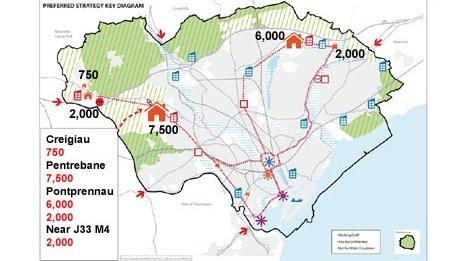Cardiff earmarks space for 45,000 new homes by 2026
- Published

Plans have been unveiled for 45,400 homes to be built in Cardiff by 2026, with the city's population forecast to rise by a quarter to more than 400,000.
The biggest single proposal is for 7,500 homes in a new suburb west of Pentrebane and about 6,000 and 2,000 earmarked either side of Pontprennau.
A further 2,000 homes could be built on land north of junction 33 on the M4.
The proposals are in Cardiff council's draft Local Development Plan (LDP) preferred strategy.
It outlines sites to build major housing and employment developments, and they include greenfield as well as brownfield.
There are also 112 submissions from developers for smaller sites in the city, but are not all expected to be included in the LDP.
According to the plan, about 18,250 homes need to be built on vacant greenfield sites while 27,600 would go on brownfield areas that need to be regenerated.
Jobs boost
But more than 5,000 hectares of countryside would also be protected.
The LDP states that about 40,000 jobs are planned by 2026.
The strategy has to go before the council's joint scrutiny committee and full council first, and then a public consultation by the end of the year.
If approved, it will be adopted in October 2015 and act as a framework for the development in Cardiff over the next 11 years.
By then it is expected the capital's population could be 408,000, a rise of 26%, according to the report.
Ralph Cook, deputy leader of Cardiff council and the authority's cabinet member for planning, said the city needed to respond appropriately to the growth of the population.
"The local development plan is fundamental to understanding those needs and fulfilling them," he told BBC Wales.
"The overall use of land under this plan is 60% brownfield and 40% greenfield and it changes the balance between urban and rural in the county, as it is currently, by just 5%.
"This is not unusual. If a city doesn't grow, it dies."
Mr Cook added that factored into the plan are the ways the infrastructures will be provided from roads right through to schools, which will be included when the final version comes out in 2015.
'Challenged'
"There's a long way to go until we get to there but this is the first stage we have to get under our belts," he added.
"We know that this will be challenged, we know there will be many people upset by the idea of houses being built very close their houses which were only built 10 years ago and we can expect that."
A Shelter Cymru spokesperson said the council's commitment to building new homes will help ease the shortage of affordable homes in Wales.
"It is not just a simple matter of the number of new homes built. It's just as important to develop communities where people want to live that will be sustainable in the long term, so it's essential that the authority's also focuses on regenerating existing housing estates.
"In the meantime, we would also urge Cardiff council to continue working to bring long-term empty properties back into use - while the proposed new homes are welcome, empty homes can be brought back into use relatively quickly and cheaply to help meet local housing need."
- Published22 April 2012
- Published17 April 2012
- Published20 January 2012
- Published12 January 2011